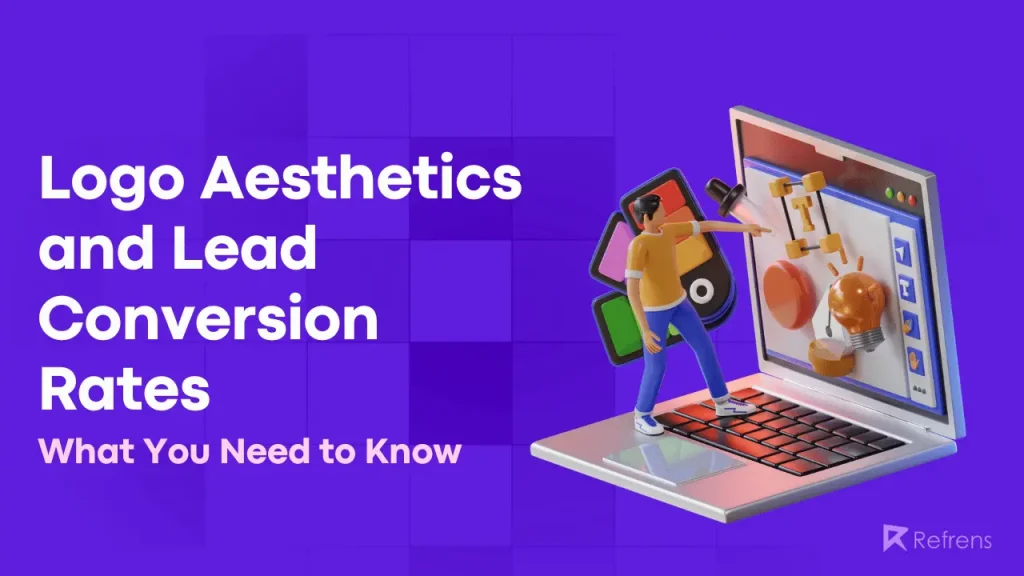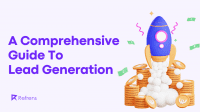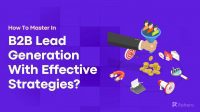In today’s digital age, where attention spans are shrinking and competition is fierce, the significance of a well-designed logo cannot be overstated. Your logo is the visual representation of your brand, and its aesthetics play a crucial role in influencing lead conversion rates. In this article, we will explore the intricate relationship between logo aesthetics and lead conversion rates, backed by statistics and expert insights, to help you make informed decisions about your brand’s visual identity.
The Psychology of Logo Aesthetics
Let’s begin by delving into the psychology behind logo aesthetics. Human beings are highly visual creatures, and our brains are wired to process visual information quickly. Studies have shown that it takes just 13 milliseconds for our brains to process an image, making the first impression a pivotal moment for your brand. A well-crafted logo, created with a free logo maker, can evoke emotions, establish trust, and communicate your brand’s values, all within that split-second timeframe.
Color choice is a fundamental aspect of logo design. Research by the Pantone Color Institute found that up to 85% of consumers’ purchasing decisions are influenced by color. For example, the color blue is often associated with trust and reliability, which is why it is prevalent in logos of financial institutions like American Express and PayPal. On the other hand, the vibrant red used by brands like Coca-Cola and Netflix can stimulate excitement and urgency.
Typography is another key element. The font you choose can convey different personalities for your brand. Serif fonts like Times New Roman suggest tradition and professionalism, while sans-serif fonts like Helvetica convey modernity and simplicity. The alignment and spacing of text can also impact readability and perception. All these elements combined contribute to the overall aesthetics of your logo.
Statistics on Logo Impact
To further underscore the importance of logo aesthetics, let’s turn to some compelling statistics:
- Recognition and Trust: According to a study by Nielsen, 59% of consumers prefer to buy products from brands they recognize. A memorable logo is a significant contributor to brand recognition.
- First Impressions: A study published in the journal “Cognition” found that people form their first impressions of a website in just 50 milliseconds. A logo maker can be used to create a visually appealing logo which creates a positive initial impression.
- Brand Loyalty: Research by the Harvard Business Review revealed that customers who have an emotional connection with a brand are 52% more valuable than those who don’t. A well-designed logo can foster such emotional connections.
- Online Engagement: A report by Adobe found that posts on social media with compelling visuals, including logos, receive 650% more engagement than text-only posts. This heightened engagement can lead to increased leads.
Logo Redesign and Conversion Rates
If you already have a logo but are considering a redesign, it’s essential to approach it strategically. A logo redesign can have a significant impact on lead conversion rates, but it must be done thoughtfully to avoid alienating existing customers. It’s a delicate balance between maintaining brand continuity and updating for modern appeal.
A case in point is the Airbnb logo redesign in 2014. They transitioned from a simple, blocky logo to the now-famous “Bélo” symbol, which represents “belonging.” While the new logo received mixed reactions initially, it successfully conveyed Airbnb’s new brand message of inclusivity and belonging. This rebranding contributed to a 30% increase in bookings within a year.
It’s worth noting that logo redesigns should go hand in hand with an overall brand strategy. If your logo evolves to reflect a change in your brand’s mission, values, or target audience, your marketing efforts should align accordingly to maximize lead conversion rates.
Logo Consistency Across Platforms
Maintaining logo consistency across various marketing platforms is paramount for effective lead conversion. Inconsistencies in logo appearance can confuse potential customers and erode trust. Your logo should be adaptable to different formats and sizes, from social media avatars to billboard advertisements.
Additionally, optimizing your logo for mobile devices is crucial in today’s mobile-centric landscape. A study by Google found that 53% of mobile site visitors leave a page that takes longer than three seconds to load. A logo that’s too large or complex can slow down your website, resulting in potential leads bouncing off before they even engage with your content.
The Impact of Simplicity and Memorability
Simplicity is a principle that cannot be overstated when it comes to logo design. The more complex your logo, the harder it is for viewers to process and remember. You can use a logo generator to generate simple and easy to remember logos. A study by Siegel+Gale found that 55% of consumers are willing to pay more for products from brands that they believe provide a simpler experience. A clean, simple logo not only enhances memorability but also contributes to a positive user experience, ultimately boosting lead conversion rates.
Consider the Nike Swoosh, one of the most recognizable logos globally. Its simplicity makes it easily identifiable, and it’s synonymous with the brand’s message of athleticism and achievement. This simplicity extends to its use on merchandise, making it highly versatile and memorable.
The Versatility of Logo Aesthetics
As your business grows and expands into different markets or ventures, your logo may need to adapt to various contexts. This versatility is essential for maintaining consistency and brand recognition. For example, McDonald’s golden arches have remained a constant symbol of the brand, whether on a street sign, packaging, or advertising. Beyond visual consistency, your logo’s symbolic meaning is key to conveying your brand’s identity.
A logo that can be adapted to different color schemes, backgrounds, and sizes is invaluable in ensuring that your brand remains cohesive and recognizable across diverse marketing channels.
Conclusion
In conclusion, the aesthetics of your logo are intricately linked to lead conversion rates. A well-designed logo can evoke emotions, build trust, and leave a lasting impression on potential customers. As demonstrated by various statistics and case studies, logo aesthetics play a significant role in brand recognition, trust, and ultimately, lead conversion rates.
If you’re considering a logo redesign, approach it strategically and in alignment with your brand’s overall mission and values. Remember that logo consistency across platforms and adaptability to different contexts are key factors in ensuring a positive user experience and maximizing lead conversion rates. In the ever-competitive business landscape, investing in your logo’s aesthetics is an investment in the success and growth of your brand.
Also learn: How to Master B2B Lead Generation with Effective Strategies?


















